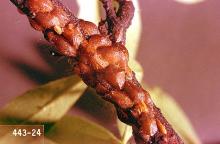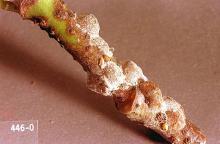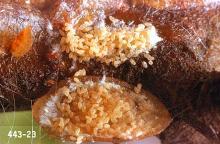Includes
Cottony scale (Pulvinaria spp.)
European fruit lecanium (Parthenolecanium corni)
Excrescent scale (Eulecanium excrescens)
Pest description and crop damage Lecanium scale is the most problematic species in hazelnuts, occasionally reaching high enough levels to require control. Mature scale are up to 0.2 inch across, reddish brown, and rounded, resembling small helmets or bumps on branches, stems, and the underside of leaves. Adult female cottony scale produces copious amounts of white cottony filaments containing eggs in summer, making them more apparent. The crawlers are flat, oval, and pinkish brown. Chemical management can target the female scale or the crawler stage. Scale insects are closely related to aphids, mealybugs, and whiteflies, and have piercing and sucking mouthparts. Severe infestations can kill twigs and may have reduced nut size and kernel fill similar to aphids. Large quantities of honeydew lead to the growth of sooty mold fungus. Sooty mold can impede photosynthesis, severely devitalizing plants and retarding growth.
Biology and life history Lecanium scale overwinters as an immature scale on twigs and branches. They resume feeding in the spring, and eggs are laid underneath the scales from May to June. The eggs remain under the scales until hatching in early summer. The emerging young scales, called "crawlers," migrate to the undersides of leaves to feed. The crawlers are most susceptible to insecticides. Young scales also can be dispersed by wind, rain, irrigation, or by the movement of people and machinery. After 4 to 6 weeks on the leaves, the young females return to the stems and twigs to feed, mate, and overwinter. The males form pupal cases along the branches and trunk and winged adults emerge to mate the females. The males are short-lived and do not feed. The remains of the white pupal cases of the males are often encountered by growers during winter during pruning. There is one generation per year.
Management-biological control
Parasitoids attack scale and scale outbreaks may be the result of broad-spectrum insecticide use causing the parasitoid population to decline. Monitor biological control by scouting for small emergence holes on the mature female scales where the parasitoid has chewed its way out of the scale host.
Management-cultural control
Home orchardists: Scale can be rubbed off plants by hand with a glove or toothbrush. Major infestations can be pruned off. Tanglefootor a similar adhesive can be applied around infestations of adult scales to catch the crawler stage. As with aphids, avoid excessive nitrogen fertilizer or water applications, as this favors increases in scale populations.
Management-chemical control: HOME USE
Applications are directed at crawlers that appear in June or early July. Take precautions when treating scale to avoid disrupting pollinators that may be actively foraging on honeydew.
- azadirachtin (neem oil)-Some formulations are OMRI-listed for organic use.
- bifenthrin (as a mix with other ingredients).
- carbaryl
- gamma cyhalothrin
- plant-derived essential oils (ex. clove oil, garlic oil, peppermint oil, linseed oil, canola oil)-Some formulations are OMRI-listed and have shown efficacy against scale.
- potassium laurate (often as mix with other ingredients)
- pyrethrins (often as a mix with other ingredients)-Some formulations are OMRI-listed for organic use.
- zeta-cypermethrin
Management-chemical control: COMMERCIAL USE
- acetamiprid (Assail 70WP) at 0.57 to 1.0 oz/100 gal water (2.3 to 4.1 oz/A) (0.10 to 0.18 lb ai/A). PHI 14 days. REI 12 hr. No more than 4 applications per season.
- buprofezin (Centaur WDG) at 34.5 to 46.0 oz/A. No more than one application per season. PHI 60 day. REI 12 hr.
- clothianidin (Belay) at 3 to 6 oz/100 gal water. Use the low rate for smaller infestations or smaller trees. Apply no more than 0.2 lb ai /year. PHI 21 day. REI 12 hr.
- imidacloprid (Admire Pro) at 1.4 to 2.4 oz/A. Generic labels available. PHI 7 days. REI 12 hr.
- pyriproxyfen (Esteem 35 WP) at 3.2 to 4 oz/100 gal water (13 to 16 oz/A). Do not apply more than twice per season. PHI 21 day. REI 12 hr.
- spirotetramat (Movento) at 6 to 9 oz/A (0.09 to 0.14 lb ai/A). Minimum reapplication interval is 14 days. PHI 7 day. REI 24 hr.



